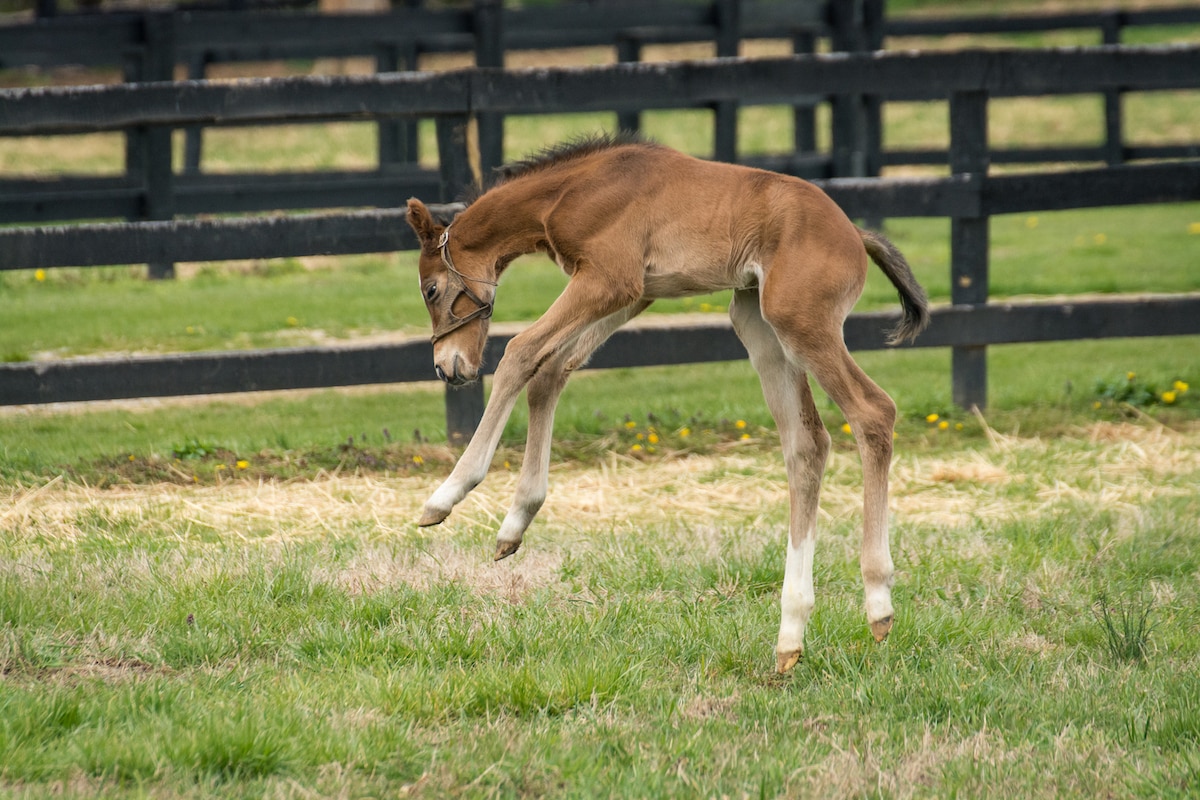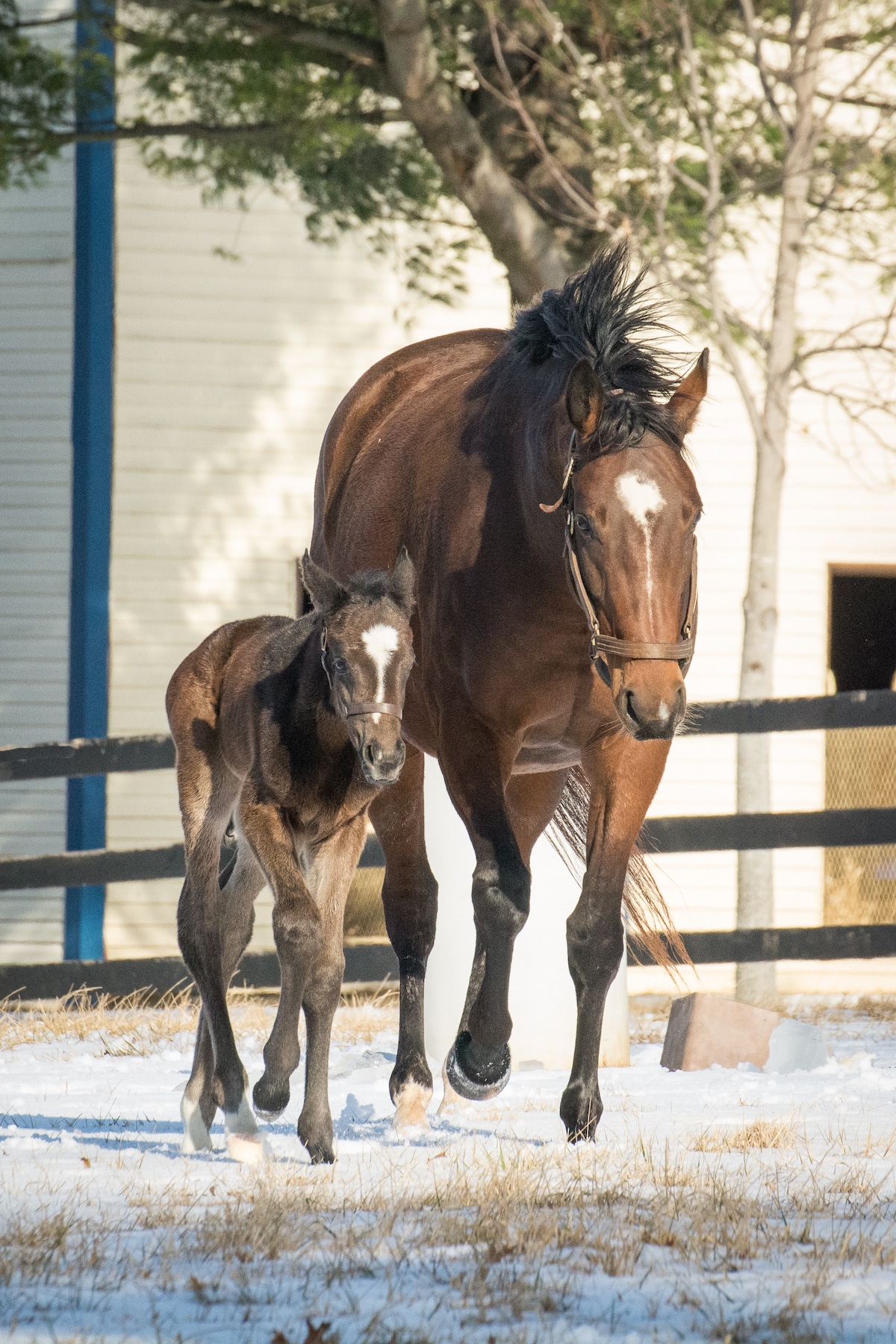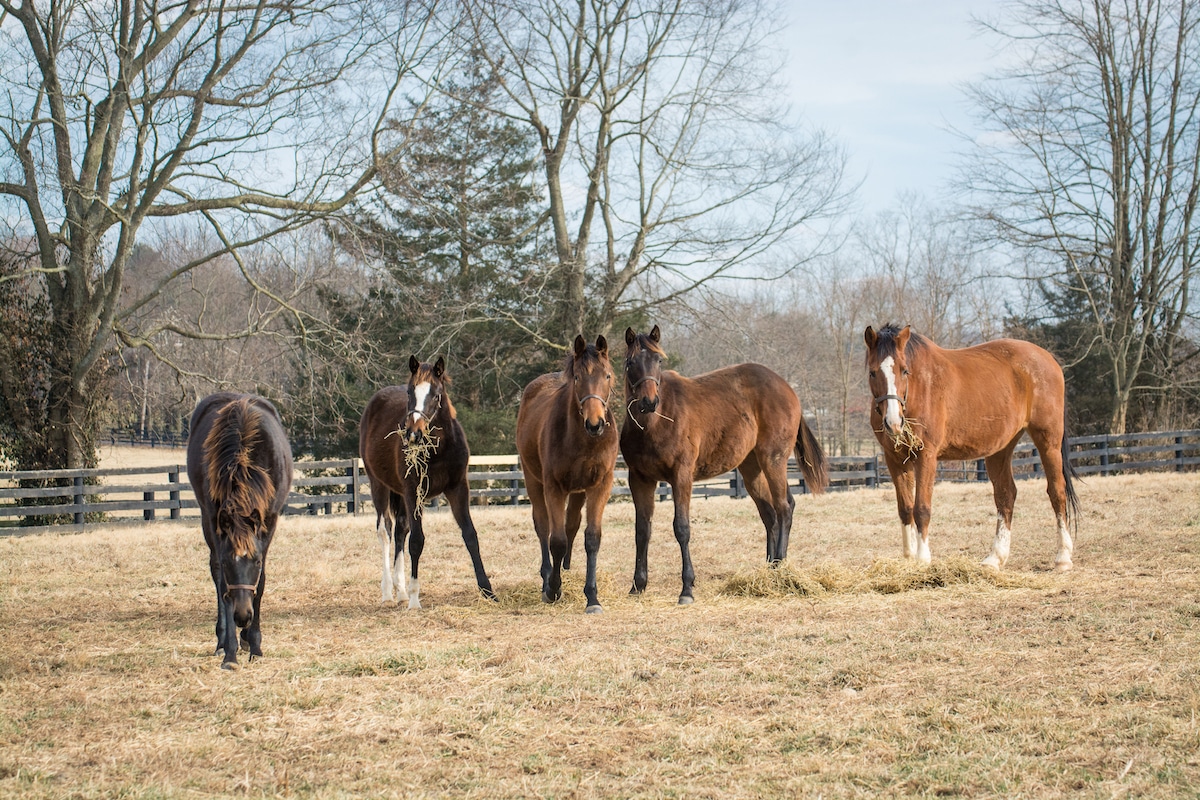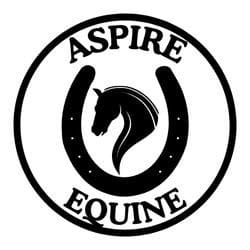How your OTTB arrived and was raised.

Thoroughbred breeding operations might oversee the care of well over 100 foals each year. Courtesy Michelle Pitts/Timber Town Stables
Regardless of whether they’ll one day achieve Triple Crown glory or never make a start on the track, foals bred to be racehorses follow a similar path at the start of their lives. Most are born at Thoroughbred nurseries that follow time-tested practices for raising strong and fast foals. Operations large and small run like well-oiled machines to produce future racehorses.
Owner Wayne Sweezey and farm manager Shelley Bunning of Timber Town Stables, in Lexington, Kentucky, oversee the care of 80 foals at their boutique 400-acre operation. Farm manager Bradley Purcell of Claiborne Farm, in Paris, Kentucky, supervises the care of 150 foals on the historic 3,000-acre property. Both farms take meticulous care of their mares and foals from initial foaling to weaning and beyond.
Foaling Protocol
Farms must be properly staffed to handle foaling dozens of broodmares. The night watchmen are crucial for keeping eyes on mares in the foaling barns as their due dates near. Sweezey says Timber Town’s foaling barn is staffed 24/7 from January to early June, because mares typically foal at night.
While both farms have well-equipped foaling barns, managers typically prefer that mares foal outside; by the end of foaling season, stalls might have housed several mares and foals, increasing the chance of harmful microbes in the environment, even though staff members disinfect stalls thoroughly before each new arrival.
“If the weather is good and not too cold, we will take a mare out to a small paddock to foal,” Purcell says. “If the weather is too cold, we will make sure the stall is very clean and bed it down with extra bedding.”
When the time comes for foaling, “we are there to help, but we are not there to do it for them,” says Bunning.
Purcell says the foal’s presentation during delivery is one of his and his colleagues’ top concerns during the foaling process. “Both front feet should be first, with the feet facing downward, and the head should be right behind that,” he says. “If this is the presentation, most of the time everything will go smoothly.”
Maiden mares having their first foals or mares with large foals might require more assistance than veteran broodmares in straightforward foaling situations, Sweezey adds.
Purcell and his staff focus on keeping the environment as relaxed as possible for foaling. “We don’t rush the mare and stress her out,” he says. “After she foals, we also give the mare and foal time to relax. We don’t rush in and try to do too much. This is the time when the mare and foal do their bonding.”
Newborn foals require specific care to keep them healthy from the start. Bunning says she and the Timber Town staff treat each foal’s umbilical cord stump with chlorhexidine to prevent infection and administer an enema to help the foal pass the meconium — his first manure. Once the mare and foal are both up, the foal is ready to nurse and receive his dam’s all-important colostrum (first milk) that will provide essential antibodies for building a strong immune system.
The staff also tests each mare’s colostrum; if it has insufficient antibodies they supplement it using their own colostrum bank. “We are very conscious of the amount of colostrum the foal receives because that is the immunity boost that they get immediately … (against) all the bugs they are probably going to come into contact with,” says Sweezey.
As an added layer of protection, the Timber Town staff gives their foals antibody-rich hyperimmunized plasma created specifically for their farm. “We give them … about five doses (of oral plasma) through the night, so they have a good boost from that, as well,” says Bunning.
“Within 12-20 hours (after birth), the (gastrointestinal tract) pretty much seals itself over and stops accepting those kinds of antibodies and protection,” Sweezey adds.
Housing and Care of Young Foals and Their Dams

For their first week or two of life, most foals and their dams get turned out in small paddocks by themselves until ready to join a larger herd. Courtesy Michelle Pitts/Timber Town Stables
After a normal foaling, the next steps aim toward helping the foal grow into a healthy horse. The day after a foal is born at Timber Town or Claiborne (even if the mare foals outside, the pair is usually brought back inside at night), dam and baby get turned out in a small paddock.
“For the first couple of days, the mares and foals will go out anywhere from two to six hours,” Purcell says. “It really depends on how strong the foal is and if there were any complications from foaling.”
For foals that have conformational defects, such as weak knees or pasterns, turnout is limited until the flaw improves naturally or a veterinarian and/or farrier corrects it.
“You have got to be careful not letting the foal go out and run too much and maybe stress a sesamoid bone or do damage to a knee joint,” Sweezey says. “We have some very small pens that we use (for these foals) because we feel it is very important to at least get out in something larger than a stall.”
Mares and foals are typically housed in paddocks and foaling barns for nine to 12 days until after the mare goes through her first heat. At this point she’s less likely to become agitated when she and her foal join other mares and foals full-time out in a larger field. Sweezey says this is also safer for the foal and gives his eyes time to develop, so they can recognize their dams out of a group of four to six broodmares — his preferred group size. He and Bunning select broodmare “pods” ahead of time based on foaling date, so mares will foal around the same time and go back into familiar groups.
“We will try to pair up a bay and a chestnut and older mares with maiden mares because you don’t want two maiden mares getting confused (about which foal is theirs),” Bunning adds. “The older, experienced mares also bring a sensible aspect to the group, keeping everyone settled and safe.”
As foals mature they begin to show interest in eating grain, which Purcell says usually happens when they are a month old. Bunning says Timber Town caretakers “hang the foals their own feed tubs in the stalls, and the mares will be tied up for an hour to an hour and a half to give the foals time to eat their own feed.” The foals also seem to find some comfort in having their own feed tub when it comes time for them to be weaned, she says.
Weaning

These Timber Town weanlings live together in a field with a pony named Dutch (right) as their babysitter. Courtesy Michelle Pitts/Timber Town Stables
Foals typically get weaned from their dams when they’re around five or six months of age. Both farms practice field weaning, which Purcell explains is when they “take the mares out of the fields and leave the foals where they have been raised.”
Bunning aims to wean gradually, beginning by removing one or two mares from the field at a time until all mares are gone. A pony gelding then joins the field of foals to serve as a mature babysitter.
To make the process easier on the mares, says Bunning, they all move into a field together. “The foals keep the same barns, stalls and fields,” she says. “It just keeps everything quiet and happier, rather than having four foals running around looking confused” in a new environment.
The Big Picture
Thoroughbred nursery managers orchestrate their activities with mare and foal care at the forefront. “There are so many moving parts throughout the year,” Sweezey says. “Our job at the very top is twofold: One is to keep the horse healthy, and the other is to keep the horse safe.”
A lot of work goes into reaching those objectives, but well-run Thoroughbred nurseries are up to the task.
This article was originally published in the Winter 2019 issue of Off-Track Thoroughbred Magazine, the only publication dedicated to the Thoroughbred ex-racehorse in second careers. Want four information-packed issues a year delivered to your door or your favorite digital device? Subscribe now!

